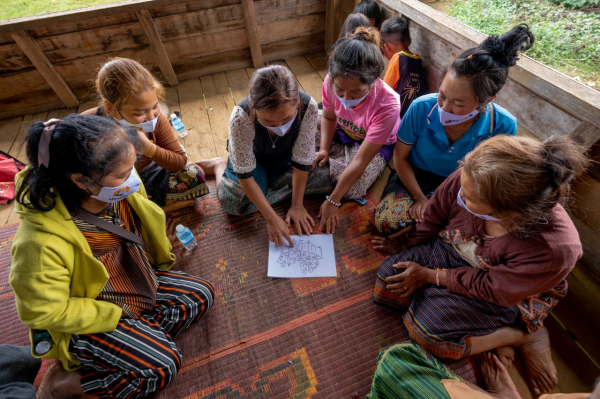ຂປລ
(KPL) “Violence against women doesn’t exist in our village”. This was the prevailing answer from men and women when the United Nations Development Programme (UNDP) and the Lao Women’s Union (LWU) conducted their first community outreach field mission last year in Bokeo.

(KPL) “Violence against women doesn’t exist in our village”. This was the prevailing answer from men and women when the United Nations Development Programme (UNDP) and the Lao Women’s Union (LWU) conducted their first community outreach field mission last year in Bokeo.
However, it is clear from data that violence against women exists in every section of society.
According to the 2014 National Survey on Violence against Women, more than 30% of ever-partnered women in the Lao PDR have experienced physical, sexual, or emotional violence by a male partner in their lifetime. During the COVID-19 lockdowns last year, the LWU Counselling and Protection Centre reported a three to five-fold increase in the number of calls they received to their hotlines requesting support and assistance.
COVID-19 demonstrated how challenging it is for remote communities to access basic information. Through the Community Outreach for Gender Equality in Coexisting with COVID-19 Project, supported by the Korea International Cooperation Agency (KOICA), LWU and UNDP sought to ensure that women, especially those in rural areas, have access to the information they need during times of COVID-19, especially on violence against women.
For LWU to improve information services and create real social and behavioural change, they needed to adopt more interactive outreach with communities to better understand people’s perceptions on violence.
“Asking direct questions didn’t get us anywhere, especially on a topic as sensitive as violence against women,” said Ms. Catherine Phuong, Deputy Resident Representative, UNDP, “We needed insights into people’s perceptions on violence and what is stopping them from changing, in order to understand how to instigate that change, which is why we used storytelling.”
The storytelling method is an indirect way of extracting people’s perceptions on issues. By asking people to share their imagined stories rather than their lived experiences, a safe space could be created to gain insight into their perceptions and actual experiences.
From March 14 to 24, 2022, UNDP and LWU travelled to Xepon District, Savannakhet Province and Paksong District in Champassak Province to test this method. Men and women from villages were given pictures depicting scenes of a woman experiencing one of the four types of violence: physical, sexual, emotional, economic; and were asked to elaborate with stories for each.
“The results from the outreach show that violence, in fact, does exist in communities but is often normalized so that it is not recognized as violence as outlined in the law. More interestingly, while men and women gave very different reasons for violence, both groups often believed that the women were at fault,” shared Ms. Phuong. She added that “feedback from local women was that the method of storytelling and using visual aids made it easy for them to understand and discuss the issue of violence against women in different forms.”
“Observing and testing the new method was very interesting for us,” shared Deputy President of the Champassak Women’s Union Vankham Sengsavang. “When we visit villages, we usually disseminate important information. However, by using these new interactive techniques, we can provide a safe space for women to raise issues with us. We look forward to continue working with the Lao Women’s Union and UNDP to roll-out and improve this approach, in particular to help us address issues of crucial concern in rural communities, such as violence against women.”
This month, results will be analysed by the LWU Media and Advocacy and Culture Departments with support from UNDP’s communications experts, and the storytelling method will be expanded to other provincial and district level Women’s Unions as a guiding tool to follow to conduct further research and community outreach.
KPL